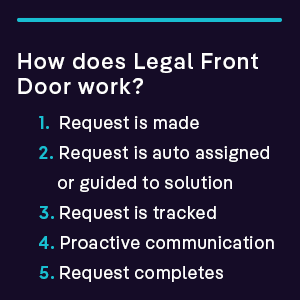A legal front door (also known as legal ticketing, or legal intake) is a secure platform that provides a single point from which business users or clients can access the legal department and its services.

It facilitates the ability to submit requests, automate processes, communicate, and promote self-service, whilst reducing admin time and providing visibility. This leads to making legal teams more accessible, which in turn promotes efficiency and positive internal client experiences.
Let’s explore the problems it’s seeking to solve, how it works and what some of the benefits are.
What problems does a Legal Front Door solve?
The concept of a legal front door is not a new one, but with digital transformation high on agendas, coupled with the need to do more with less, in-house legal teams and senior stakeholders are now seeking solutions to support them in their day-to-day activities. There’s also a drive to harness data to provide greater insights and make informed decisions.
We all know legal teams are under pressure, and with demand for their services continuing to grow, administrative tasks are more burdensome than ever. Clarity, promptness, and compliance are key. But with changing priorities, and providing timely updates on top of requests coming in via phone, email, Teams, Slack, and other methods, how do you control that? The answer? A legal front door!
Harnessing these data-driven interactions means you can track trends and understand where process bottlenecks are. You can also scale the use cases you support over time to meet the needs of an ever-changing world.
Throughout this, ease of use is key. Rather than letting the requestors drive how, and in which format they request your services, they’re instead guided through processes that legal control. Providing a single, easy-to-use access point creates confidence in a controlled manner – communication is improved and your internal clients are far more satisfied.
In addition, the legal workload is clear, and organized and tools are available to support teams as they work through requests.
How does a Legal Front Door Work?

1. Request is made: The user can choose from a list of diverse options. The technology lends itself to support any number of use cases through automated workflows.
2. On submission, requests can be auto-assigned, or guided directly to a solution: Depending on the use case, self-service can be enabled. Equally, a request can be allocated to a subject matter expert or a triage queue depending on the business’s needs and the services offered.
3. The request is tracked: From the moment the request is submitted, the process is transparent and status updates can be visible to everyone, or limited – depending on company policies.
4. Proactive communication: Share status updates automatically and use chat functions to reduce email traffic without compromising on an audit trail.
5. Complete request: The request is complete but remains accessible, future related requests are supported.
What are the Benefits of a Legal Front Door?
Client-centric with ease of use: A legal from door offers one intuitive entry point – accessible from any device, anywhere with an Internet connection. Once again, removing these barriers between legal and the rest of the enterprise significantly enhances your client experience with every legal interaction.
Improved efficiencies: Allow lawyers to spend time doing what they trained so hard for, minimize, and automate admin, be strategic, move away from being reactive and drive proactivity.
Easy triage: The legal department can now receive requests and seamlessly match the appropriate resource to take the actions required.
Data for Business Intelligence (BI) and reporting: Data is king – in any department. A tool like this uses data to drive continual improvement programs and give visibility into the trends and KPIs. In-house departments can now leverage automated reports to check on workload, gauge response times, track deliverables, and analyze other important data.
Ongoing task management: Allow access to request status,’ progress, and other pertinent information, and support proactive communication.
Experience Greater Legal Intake Visibility
Adopting a legal front door offers countless benefits for the legal team. Nevertheless, it also provides a positive customer experience, helping to build stronger relationships for the future. For example, a legal front door solution captures important information quickly and easily to prevent delays from lacking details.
Additionally, it optimizes communication workflows so clients stay well-informed and confident that their matter is being handled responsibly. These efficiencies ensure that all deadlines are met.
The benefits outlined below help maximize efficiency and productivity, whilst reducing admin, all the while legal stays in control, without compromise.
- Creates more efficient workflows based on proven data
- Single source of truth for requests, which helps teams stay organized
- Use data to make informed decisions
- Create efficient automated workflows
- Improve communication, tag a colleague, requestor, or stakeholder to make them a “watcher”
- Track trends, what are the demands on legal and how do they change over time
- Provide transparency on how long tasks are taking
- Support the prioritization of time-sensitive requests
- Automatically allocate requests to the right people, with the right tools, at the right time
- Track how are users interact with the solution and legal department
Contact us today, and discover how your organization could benefit from a smart legal front door. Find out how our team of legal and technology experts can support in other areas, such as CLM, corporate governance, policy management and more too!


